1996 PONTIAC BONNEVILLE mirror
[x] Cancel search: mirrorPage 96 of 387
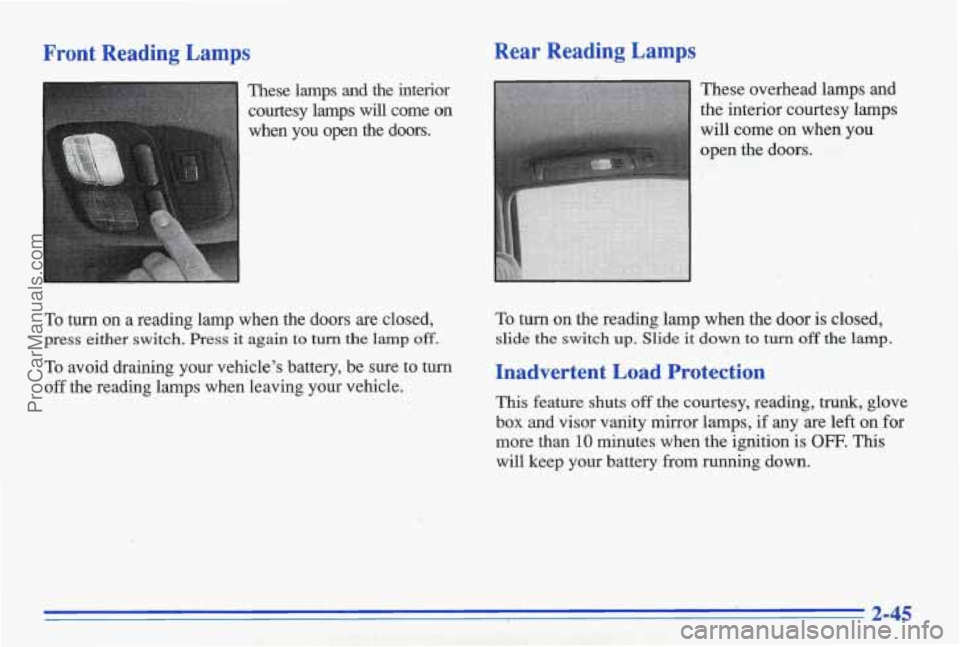
Front Reading Lamps Rear Reading Lamps
/
These lamps and the interior
These overhead lamps and
courtesy lamps
will come on the
interior courtesy lamps
when you open the doors. will come on when you
open the
doors,
To turn on a reading lamp when the doors are closed, To turn on the reading lamp when the door is closed,
press either switch. Press
it again to turn the lamp off. slide the switch up. Slide it down to turn off the lamp.
TO avoid draining your vehicle’s battery, be sure to turn Inadvertent Load Protection
off the reading lamps when leaving your vehicle. This feature shuts
off the courtesy, reading, trunk, glove
box and visor variity mirror lamps, if any are left on for
more than 10 minutes when the ignition is OFF. This
will keep your battery from running down.
..
.. :. 1
2-45
ProCarManuals.com
Page 97 of 387
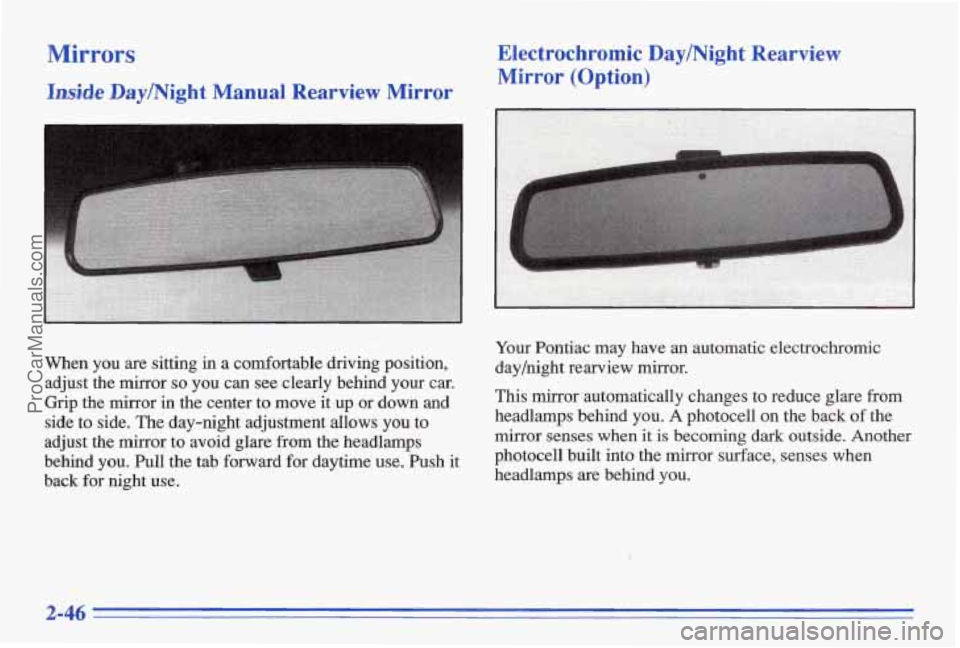
Mirrors
Iwide Day/Night Manual Rearview Mirror Electrochromic Day/Night Rearview
Mirror
(Option)
When you are sitting in a comfortable driving position,
adjust the mirror
so you can see clearly behind your car.
Grip
the mirror in the center tomove it up or down and
side to side. The day-night adjustment allows you to
adjust
the mirror to avoid glare from the headlamps
behind you.
Pull the tab f6mard for daytime use. Push it
back for night use.
Your Pontiac may have an automatic electrochromic
day/night rearview
mirror.
This mirror automatically changes to reduce glare from
headlamps behind
you A photocell on the back of the
mirror senses when it is becoming dark outside. Another
photocell built into the mirrur surface, senses when
headlamps
are behind you.
2-46
ProCarManuals.com
Page 98 of 387
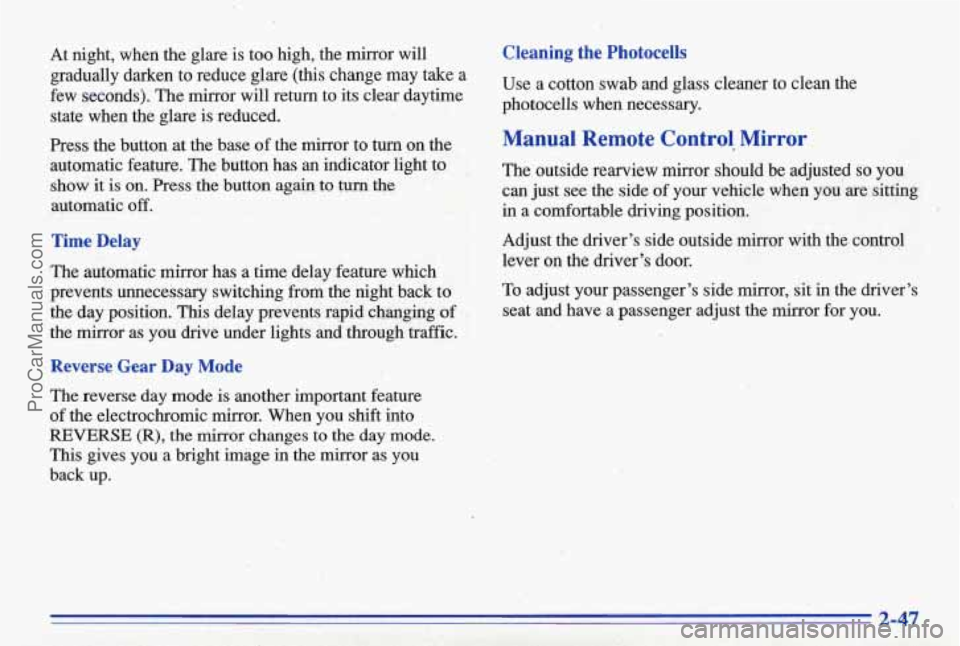
At night, when the glare is too high, the mirror will
gradually darken to reduce glare (this change may take a
few seconds). The mirror
will return to its clear daytime
state when the glare is reduced.
Press the button at the base
of the mirror to turn on the
automatic feature. The button has an indicator light to
show
it is on. Press the button again to turn the
automatic off.
Time Delay
The automatic mirror has a time delay feature which
prevents unnecessary switching from the night back
to
the day position. This delay prevents rapid changing of
the mirror as
you drive under lights ind through traffic.
Cleaning the Photocells
Use a cotton swab and glass cleaner to clean the
photocells when necessary.
' :... .. ,.
Manual Remote Control. Mirror
The outside rearview mirror should be adjusted so you
can just see the side of your vehicle when you are sitting
in a comfortable driving position.
Adjust the driver's side outside mirror with the control lever on the driver's door.
To adjust your passenger's side mirror, sit in the driver's
seat and have a passenger adjust the mirror for you.
Reverse Gear Day Mode
The reverse day mode is another important feature
of the electrochromic mirror. When you shift into
REVERSE (R), the mirror changes to the day mode.
This gives you a bright image in the mirror as you
back up.
ProCarManuals.com
Page 99 of 387
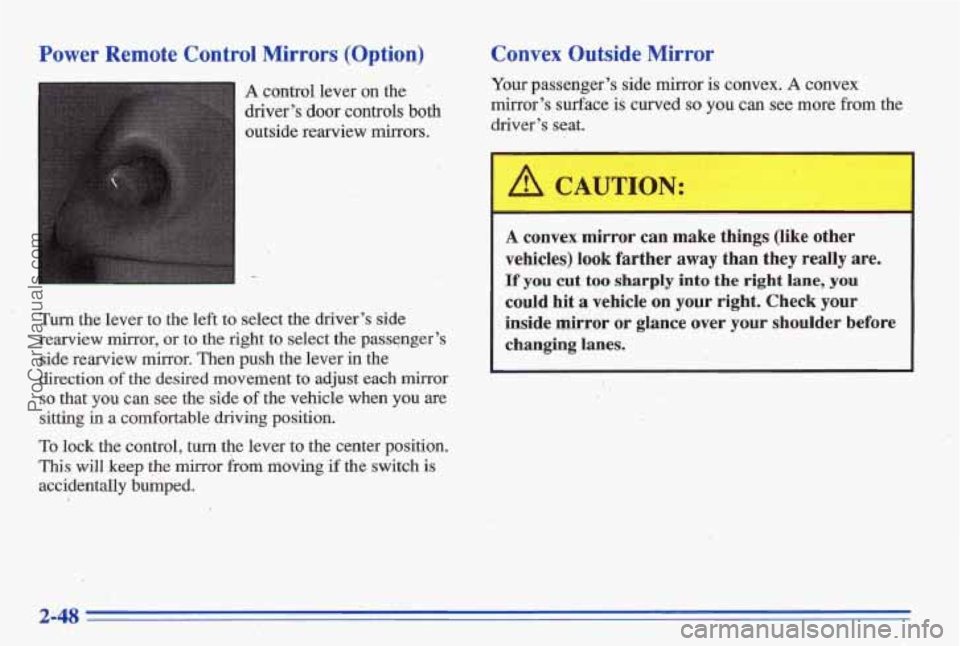
Power Remote Control Mirrors (Option)
A control lever on the ’
driver’s door controls both
outside rearview mirrors.
-
.. ’. ...
Turn the lever to the left to select the driver’s side
rearview mirror,
or to the right to select the passenger’s
side rearview mirror.
Then push the lever in the
direction
of the desired movement to adjust each &ur
so that you can see the side of the vehicle when you are
sittirag
in a comfortable driving position.
To lock the control, turn the lever to the center position.
This will keep the mirror &om moving if. the switch is
accidentally
bumped.
Convex Outside Mirror
You passenger’s ‘side mirror is convex. A convex
mirror’s. surface is curved
so you can see more from the
driver’s seat.
A CAUTION:
A convex mirror can make things (like other
vehicles) look farther away than they really are.
If you cut too sharply into the right lane, you
could hit a vehicle on your right. Check your
inside mirror or glance over your shoulder before
changing lanes.
2-48
ProCarManuals.com
Page 105 of 387

Visor Vanity Mirror Air Inflator System
Open the cover to expose the vanity mirror.
If your vehicle has the optional lighted vanity mirrors,
the lamps come on when you open the cover. You can
adjust the brightness of the lamps by moving the switch, Some vehicles have an air inflator
for use
in maintaining
proper air pressure
for the tires. The air inflator is
located in the trunk. The ON switch will work only with
the ignition
on.
ProCarManuals.com
Page 180 of 387
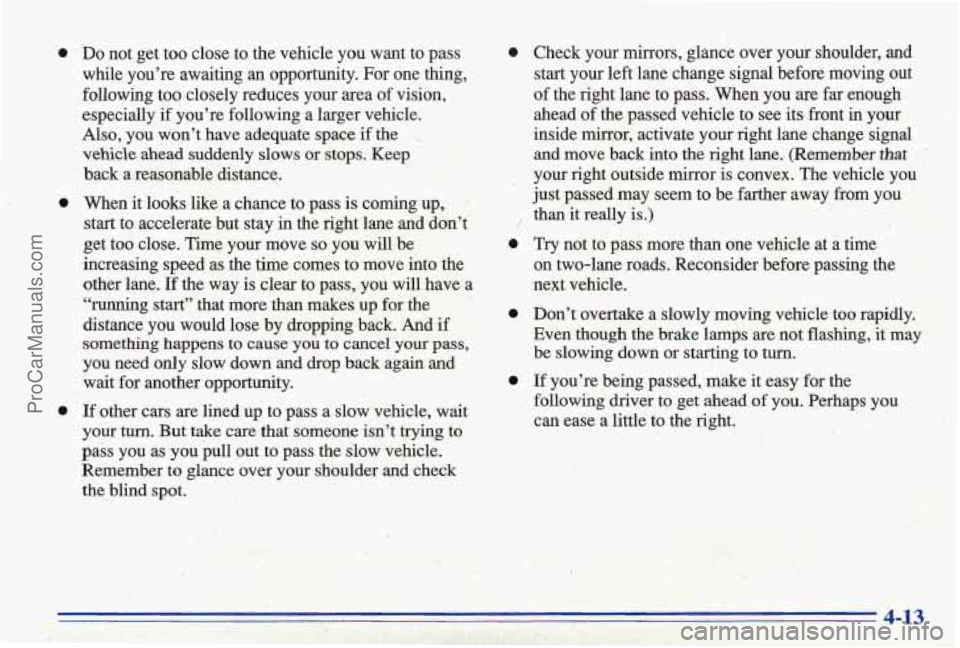
a a Do not get too close to the vehicle you want to pass
while you’re awaiting
an opportunity. For one thing,
following too closely reduces your
area of vision,
especially
if you’re following a larger vehicle.
Also, you won’t have adequate space
if the ’ ~
vehicle ahead suddenly slows or stops. Keep
back a reasonable distance.
When it looks like a chance to pass
is coming up,
start to accelerate but stay in the right lane and don’t
get too close. Time your move
so you will be
. . . -..increasing speed as the time comes to move into the
. 4, I y other lane. If the way is clear to pass, you will have a
- - -8 -“running start” that more than makes up for the
.~ ~ - .; -.: - 5;. :
. I %. ..
.. .. . > .-
a
distance-you would lose by dropping back. And if
something happens to cause you to cancel your pass,
you need only slow down and drop back again and
wait for another opportunity.
If other cars are lined up to pass a slow vehicle, wait
your
turn. But take care that someone isn’t trying to
pass you as you pull out to pass the slow vehicle.
Remember to glance over your shoulder and check
the blind spot.
a
a
a
a
Check your mirrors, glance over your shoulder, and
start your left lane change signal before moving out
of the right
lane to pass. When you are far enough
ahead
of the passed vehicle to see its front in your
inside mirror, activate your right lane change signal and move back into the right lane. (Remember
that .*
your right outside mirror is convex. The vehicle you
just passed may seem to be farther away from you
than it really is.)
Try not to pass more than one vehicle at
a time
on two-lane roads. Reconsider before passing the
next vehicle.
Don’t overtake a slowly moving vehicle too rapidly.
Even though the brake lamps
are not flashing, it may
be slowing down or starting to
turn.
If you’re being passed, make it easy for the
following driver to get ahead of you. Perhaps you
can ease a little to the right.
ProCarManuals.com
Page 181 of 387
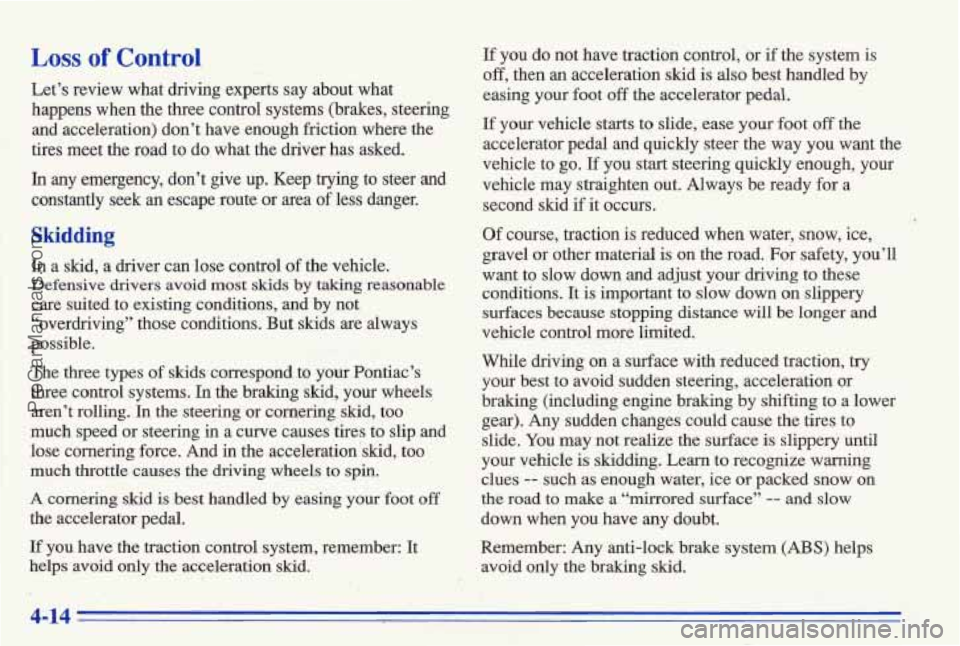
Loss of Control
Let’s review what driving experts say about what
happens when the three control systems (brakes, steering and acceleration) don’t have enough friction where the
tires
meet the road to do what the driver has asked.
In any emergency, don’t give up. Keep trying to steer and
constantly seek
an escape route or area of less danger.
Skidding
In a skid, a driver can lose control of the vehicle.
Defensive drivers avoid most skids by taking reasonable
care suited to existing conditions, and by not
“overdriving” those conditions. But skids
are always
possible.
The three types of skids correspond to your Pontiac’s
three control systems. In the braking skid, your wh’eels
aren’t rolling.
In the steering or cornering skid, too
much speed or steering in a curve causes tires to slip and lose cornering force. And
in the acceleration ‘skid, too
much throttIe causes the driving wheels
to spin.
A cornering skid is best handled by easing your foot off
the accelerator pedal.
If you have the traction control system, remember: It
helps avoid
only the acceleration skid.
If you do not have traction control, or if the system is
off, then an acceleration skid is also best handled by
easing your foot off the accelerator pedal.
If your vehicle starts to slide, ease your foot off the
accelerator pedal and quickly steer the way you want the
vehicle to
go. If you start steering quickly enough, your
vehicle may straighten out. Always be ready for a second skid if it occurs.
Of course, traction
i,s reduced when water, snow, ice,
gravel or other material
is on the road. For safety, you’ll
want to slow down and adjust your driving to these
conditions.
It is important to slow down on slippery
surfaces because stopping distance will
be longer and
vehicle control more limited.
While driving on a surface with reduced traction, try
your best to avoid sudden steering, acceleration or
braking (including engine braking by shifting to a lower
gear). Any sudden changes could cause the tires to
slide. You may not realize the surface
is slippery until
your vehicle is skidding. Learn to recognize warning
clues
-- such as enough water, ice or packed snow on
the road to make a “mirrored surface” -- and slow
down when you have any doubt.
Remember: Any anti-lock brake system
(ABS) helps
avoid only
the braking skid.
4-14
ProCarManuals.com
Page 182 of 387

Driving at Night Here are some tips on night dnving.
0 Drive defensively.
Don’t drink and drive.
Adjust your inside rearview mirror to reduce the
gl&e from headlamps behind you.
slow down and keep more space between
you and
other vehicles.
0 Since you can’t see as well, you may need to
0 Slow down, especially on higher speed roads. Your
headlamps can light up only so much road ahead.
0 In remote areas, watch for animals.
If you’re tired, pull off the road in a safe place
and rest.
Night driving is more dangerous
than day driving. One
reason is that some drivers are likely to be impaired -- by
alcohol or chugs, with night vision problems, or by fatigue.
ProCarManuals.com